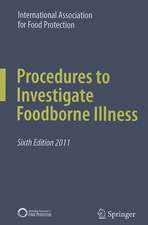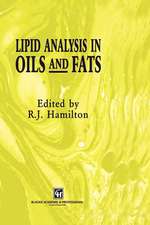Supercritical Fluid Processing of Food and Biomaterials
Autor S. S. H. Rizvien Limba Engleză Paperback – 21 noi 2011
Preț: 386.99 lei
Nou
Puncte Express: 580
Preț estimativ în valută:
74.05€ • 79.19$ • 61.74£
74.05€ • 79.19$ • 61.74£
Carte tipărită la comandă
Livrare economică 17 aprilie-01 mai
Preluare comenzi: 021 569.72.76
Specificații
ISBN-13: 9781461359074
ISBN-10: 1461359074
Pagini: 276
Ilustrații: XVII, 257 p.
Dimensiuni: 155 x 235 x 14 mm
Greutate: 0.39 kg
Ediția:Softcover reprint of the original 1st ed. 1994
Editura: Springer Us
Colecția Springer
Locul publicării:New York, NY, United States
ISBN-10: 1461359074
Pagini: 276
Ilustrații: XVII, 257 p.
Dimensiuni: 155 x 235 x 14 mm
Greutate: 0.39 kg
Ediția:Softcover reprint of the original 1st ed. 1994
Editura: Springer Us
Colecția Springer
Locul publicării:New York, NY, United States
Public țintă
ResearchCuprins
1 Fundamentals of processing with supercritical fluids.- Abstract.- 1.1 Introduction.- 1.2 Phase equilibrium and solubility.- 1.3 Mass transfer operation and economics.- 1.4 Biochemical reactions in supercritical fluids.- References.- 2 Carbon dioxide as a supercritical solvent in fatty acid refining: theory and practice.- Abstract.- 2.1 Introduction.- 2.2 Phase equilibria.- 2.3 A case study.- 2.4 Mass transfer.- 2.5 Continuous multistage simulation.- 2.6 Conclusions.- Acknowledgements.- References.- 3 Mass transfer phenomena in supercritical carbon dioxide extraction for production of spice essential oils.- Abstract.- 3.1 Introduction.- 3.2 Theory.- 3.3 Materials and methods.- 3.4 Results and discussion.- References.- 4 Biochemical reactions in supercritical fluids.- Abstract.- 4.1 Introduction.- 4.2 Acidolysis reaction.- 4.3 Materials and methods.- 4.4 Results and discussion.- 4.5 Conclusions.- Acknowledgements.- References.- 5 Use of semi-preparative supercritical chromatography for the separation and isolation of flavor and food constituents.- Abstract.- 5.1 Introduction.- 5.2 Materials and methods.- 5.3 Results and discussion.- 5.4 Conclusion.- References.- 6 Separation of oil from fried chips by a supercritical extraction process: an overview of bench-scale test experience and process economics.- Abstract.- 6.1 Introduction.- 6.2 Background.- 6.3 Laboratory-scale study of LOWCA process.- 6.4 Results and discussion.- 6.5 Conceptual design and cost study of LOWCA process.- 6.6 Technology penetration issues.- 6.7 Conclusions.- Acknowledgements.- References.- 7 Selecting a pump for supercritical fluid service.- Abstract.- 7.1 Introduction.- 7.2 Fluid criteria.- 7.3 Process criteria.- 7.4 Pump types.- 7.5 Applications and selections.- 8 Natural antioxidants produced bysupercritical extraction.- Abstract.- 8.1 Introduction.- 8.2 Traditional antioxidants.- 8.3 Spice antioxidant compounds.- 8.4 Extraction of spice antioxidants.- 8.5 Supercritical extraction.- 8.6 Labex™ spice oleoresin SC™.- 8.7 Analytical.- 8.8 Summary.- References.- 9 Separation of ethanol/water solution with supercritical CO2 in the presence of a membrane.- Abstract.- 9.1 Introduction.- 9.2 Materials and methods.- 9.3 Results and discussion.- 9.4 Conclusions.- Nomenclature.- References.- 10 Supercritical fluid fractionation of butter oil.- Abstract.- 10.1 Introduction.- 10.2 Materials and methods.- 10.3 Results.- 10.4 Conclusion.- References.- 11 Supercritical carbon dioxide processing of orange juice: effects on pectinesterase, microbiology and quality attributes.- Abstract.- 11.1 Introduction.- 11.2 Materials and methods.- 11.3 Results and discussion.- 11.4 Summary and conclusions.- Acknowledgements.- References.- 12 Supercritical fluid carbon dioxide technology for extraction of spices and other high value bio-active compounds.- Abstract.- 12.1 Introduction.- 12.2 Pepper oil.- 12.3 Pepper oleoresin.- 12.4 Ginger oil.- 12.5 Ginger oleoresin.- 12.6 Jasmine absolute.- 12.7 Bio-active compounds.- 12.8 Summary.- References.- 13 Extraction of oil from evening primrose seed with supercritical carbon dioxide.- Abstract.- 13.1 Introduction.- 13.2 Experiments.- 13.3 Results and discussion.- 13.4 Conclusions.- Nomenclature.- References.- 14 High pressure extraction of organics from water.- Abstract.- 14.1 Introduction.- 14.2 Apparatus and methods.- 14.3 High pressure extraction of water solutions.- 14.4 Results and discussion.- 14.5 Conclusion.- Nomenclature.- References.- 15 Production of low-fat and low-cholesterol foodstuffs or biological products by supercriticalCO2 extraction: processes and applications.- Abstract.- 15.1 Introduction.- 15.2 General process.- 15.3 Food products: defatting applications.- 15.4 Food products: defatting and decholesterol applications.- 15.5 Biological products: decholesterol applications.- References.- 16 Fractionation of beef tallow with supercritical CO2.- Abstract.- 16.1 Introduction.- 16.2 Materials and experimental methods.- 16.3 Results and discussion.- 16.4 Conclusions.- Acknowledgements.- References.- 17 Supercritical CO2 extraction of oil from a seaweed, Palmaria palmata.- Abstract.- 17.1 Introduction.- 17.2 Materials and methods.- 17.3 Results and discussion.- 17.4 Conclusion.- Acknowledgements.- References.- 18 Commercial feasibility of supercritical extraction plant for making reduced-calorie peanuts.- Abstract.- 18.1 Introduction.- 18.2 Market potential for reduced-calorie peanuts.- 18.3 Plant and process design criteria.- 18.4 Commercial viability.- 18.5 Results of feasibility analysis.- 18.6 Economic considerations.- 18.7 Conclusions.- Appendix: Measures of profitability.- References.- 19 In situ monitoring of selective extraction of a mixture of higher fatty acids with supercritical carbon dioxide.- Abstract.- 19.1 Introduction.- 19.2 Materials and methods.- 19.3 Results and discussion.- References.




























